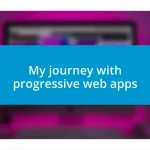Key takeaways:
- User testing reveals not only usability issues but also emotional connections, emphasizing the importance of understanding users’ experiences and perspectives.
- Fostering empathy through user feedback is essential for product refinement, bridging the gap between user expectations and design intentions.
- Analyzing user testing results requires attention to both quantitative data and qualitative insights, guiding effective design improvements and iterations.

Understanding user testing fundamentals
User testing is really about understanding your users at a deeper level. I remember a project where we organized a testing session, and watching participants struggle with basic navigation was an eye-opener. It made me realize how crucial it is to step into the users’ shoes and truly observe their interactions with your product.
When you think about user testing, it’s important to remember that it’s not just about gathering data; it’s about the stories behind that data. During one session, a user shared how a minor design element triggered a frustrating memory from their childhood. That moment highlighted the emotional connections users have with interfaces, reminding me that behind every click is a person with feelings and experiences.
Each testing session is a unique learning opportunity; you never know what insights might emerge. Have you ever considered how a slight tweak could transform your users’ experience? I often find that those small adjustments can lead to significant improvements, proving that user testing is both an art and a science.

Importance of user testing
User testing plays a pivotal role in the design process. I can recall a scenario where we made a significant decision based on user feedback from a testing group. The users were not just pointing out flaws; they were revealing their mental models and expectations, which had a profound impact on how we refined our design. This experience illustrated to me that user testing is about bridging the gap between the user’s perspective and our design intentions.
The importance of user testing is evident in the way it fosters empathy. During a recent session, a participant became visibly frustrated when a feature they assumed would work a certain way didn’t. Their reaction prompted a deep discussion about assumptions we, as designers, may take for granted. I’ve learned that by observing genuine reactions, we not only refine our products but also cultivate a deeper understanding of the human experience entwined with technology. This emotional connection is what makes user testing invaluable.
When we talk about the stakes in design, user testing can be the difference between a mediocre product and one that resonates deeply with its audience. I remember rolling out an update that I felt confident about but received overwhelmingly negative feedback during user testing. It was a tough moment, but it underscored the essence of testing: focusing on users’ needs above our own biases. This reality check not only shaped the product but also reinforced the lesson that prioritizing user needs is non-negotiable.
| Benefits | User Testing |
|---|---|
| Empathy Development | Encourages designers to understand users’ emotions and perspectives. |
| Product Refinement | Identifies areas for improvement based on real user feedback. |
| Risk Mitigation | Helps avoid costly mistakes by addressing issues before launch. |

Common user testing methods
User testing is a diverse arena filled with methods that can illuminate user behaviors and preferences. One standout method is moderated usability testing. In my experience, having a facilitator present during the testing session brings out insights that can easily be overlooked when users are left to navigate alone. I once guided a focus group where, after observing gestures of confusion and frustration, we discovered a critical misunderstanding of our product’s primary function. This interaction was not just a data point; it sparked in-depth follow-up conversations that changed our design approach drastically.
Another method worth noting is unmoderated testing, which allows users to engage with a product in their own environment at their convenience. While I found that this method often yields raw, honest feedback, I also learned that it can sometimes miss the nuanced emotional reactions that moderated sessions can capture. Here are several common user testing methods that I’ve found to be particularly effective:
- Moderated Usability Testing: Conducted with a facilitator who can probe deeper into user thoughts and behaviors.
- Unmoderated Usability Testing: Enables users to test out products independently, providing authentic feedback without external influence.
- A/B Testing: Compares two versions of a product to see which one performs better based on user interactions.
- Focus Groups: Engages a diverse group of users to discuss their perceptions and feelings around a product.
- Surveys and Questionnaires: Gathers structured feedback, allowing for quantitative analysis of user opinions and preferences.
With these methods in your toolkit, you can start to see the multifaceted world of user testing unfold, enriching your understanding of user interactions.

Preparing for user testing sessions
Preparing for user testing sessions requires a mix of thoughtful planning and flexibility. I’ve learned the hard way that creating an environment where participants feel comfortable is crucial. I remember one session where a participant hesitated to voice their opinions, likely because they felt intimidated by the atmosphere. Once I opened up the floor with casual conversation, the feedback flowed more freely and honestly.
Choosing the right participants is equally important. After one memorable testing session, I realized that pairing users who are too similar can lead to a narrow view of feedback. I once recruited users from a homogenous group, and the insights felt repetitive. By diversifying the group–bringing in people with varying backgrounds and levels of experience–I discovered richer, more authentic reactions that ultimately guided our design in unexpected ways.
Finally, I always emphasize the value of a well-structured session. In one instance, I arrived with a rigid outline, thinking it would streamline the process. However, I quickly learned it’s essential to remain adaptable. A single question I asked sparked a completely different conversation that uncovered a significant usability issue we hadn’t anticipated. This taught me that while preparation is key, allowing space for organic dialogue can lead to the most valuable insights. Have you ever encountered an unexpected breakthrough during a session? It’s moments like these that make user testing so fascinating.

Analyzing user testing results
Analyzing user testing results is one of the most eye-opening aspects of the process. I’ve experienced firsthand that digging into the data isn’t just about spotting trends; it’s about unraveling the story behind those numbers. For instance, after one test, I discovered that a series of users dropped off at a particular step. Instead of just noting the dropout rate, I decided to explore that moment more deeply, leading to a candid conversation with my team about potential usability hurdles we hadn’t considered.
It’s also essential to focus on both quantitative and qualitative data. When I reviewed survey scores alongside user comments, the contrast was striking. I remember a specific instance where a product scored an average rating yet had users emotionally expressing their admiration in open-ended feedback. This juxtaposition highlighted the disconnect between numbers and genuine experiences. Isn’t it fascinating how raw emotions can coexist with statistical data? It really drove home the complexity of user behavior.
Lastly, visualizing the results can be incredibly beneficial. During one project, I started using heatmaps to track user interactions. What did I find? Areas of unexpected interest emerged, revealing where users lingered, clicked, and got confused. This clarity helped the entire team visualize not just the issues at hand but also the paths we could take moving forward. How do you visually represent your findings? Crafting a compelling narrative around the data can transform how we approach design improvements.

Applying insights from user testing
I’ve found that applying insights from user testing can be transformative for a project. For instance, after observing users struggle with a navigation menu, I took their feedback and restructured it completely. The result? A smoother user journey that not only enhanced satisfaction but increased engagement. Isn’t it rewarding to see how a simple tweak can lead to profound improvements?
Moreover, integrating user feedback into our design process isn’t always easy; it requires balancing user desires with technical feasibility. I recall a time when a user passionately suggested a feature we were hesitant to implement due to resource constraints. Rather than dismissing it, I invited the whole team to brainstorm ways we could tweak existing functionalities to achieve a similar outcome. This collaboration not only validated the user’s feelings but also sparked creativity within our team. Have you ever faced a similar challenge that turned into an opportunity for innovation?
Finally, continuous iteration based on user insights can keep a product aligned with user needs. I distinctly remember revisiting a product after a few months and finding that features I thought were successful were now causing confusion. Armed with user insights, I facilitated a redesign workshop where we let real user quotes drive our decisions. The back-and-forth energy during that session was electric, and it proved how essential it is to keep the user voice alive throughout the development cycle. It made me wonder: how often do we truly listen to those using our products?

Enhancing usability through user feedback
Great user feedback can significantly enhance usability, as I’ve personally learned through various testing sessions. One of those moments was when a user pointed out that a button’s color blended too much with the background. After we adjusted it, I witnessed firsthand the immediate relief and joy on users’ faces when navigating through the interface. Isn’t it amazing how a simple design choice can make someone feel more at ease?
In another instance, I remember organizing a user feedback session right after deploying a new feature. Initially, I was nervous about how the changes would be received. However, hearing users share their genuine thoughts, both positive and critical, felt like uncovering hidden treasures. Their candid feedback helped illuminate pain points I hadn’t considered, reinforcing the idea that user opinions are an invaluable compass in navigating design choices.
Embracing user feedback also taught me the importance of empathy. I often remind myself that behind every click and interaction is a real person with their own needs and frustrations. When a user struggled to find a specific feature, it prompted me to put myself in their shoes—how would I feel in their position? This perspective shifted my outlook on design, emphasizing that usability stems from understanding users deeply and prioritizing their experiences. Have you ever felt that spark of understanding when seeing something through someone else’s eyes? It’s truly enlightening.












